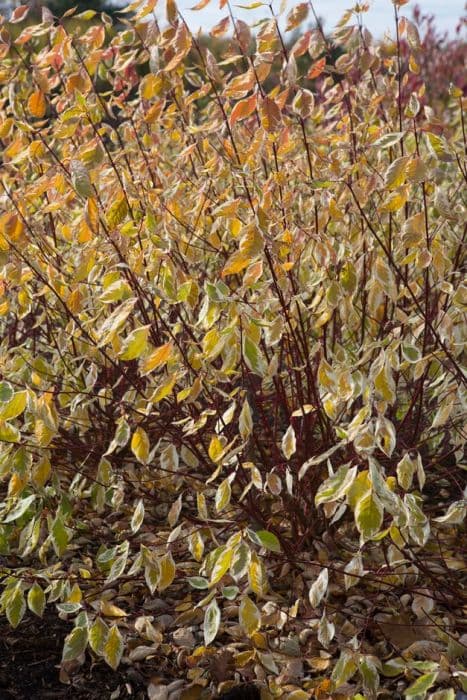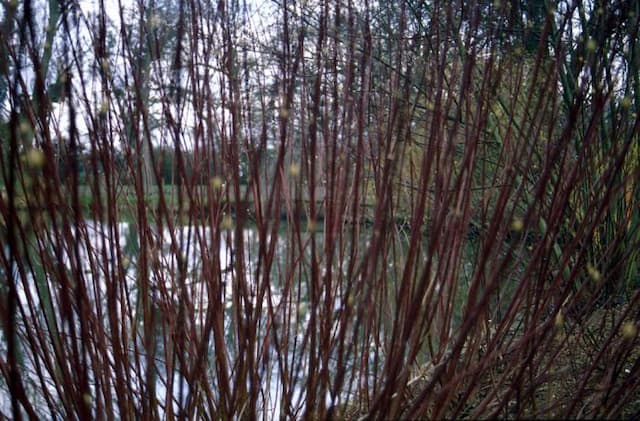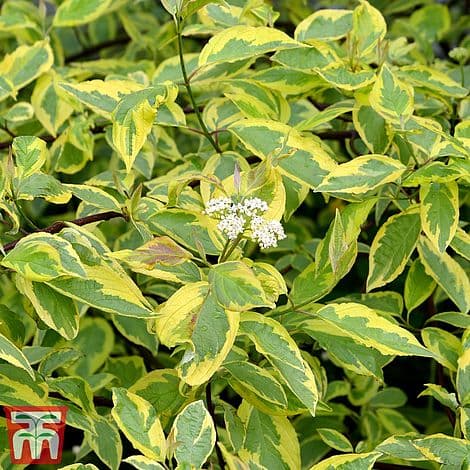Red Twig Dogwood Cornus alba 'Ruby'

ABOUT
The plant known as Ruby Red Twig Dogwood has a stunning appearance marked by its vibrant red stems that stand out in a garden, especially during winter when the plant has lost its foliage. The leaves are oval-shaped with a pointed tip and display a bright green color that transitions to a maroon or reddish-purple shade in the fall, providing a colorful autumn display. In the late spring to early summer, the Ruby Red Twig Dogwood produces clusters of small white flowers that add to its ornamental value. These flowers are followed by white to bluish-white berries that attract birds and other wildlife. The bark, with its bright red hue that intensifies during the winter months, is smooth and adds visual interest to the landscape, making it a sought-after plant for year-round beauty.
About this plant
 Names
NamesSynonyms
Red-Barked Dogwood, Siberian Dogwood, White Dogwood
Common names
Cornus alba 'Ruby'.
 Toxicity
ToxicityTo humans
The plant commonly known as Red Osier Dogwood is not generally considered toxic to humans. However, it is always advisable to avoid ingesting parts of ornamental plants due to potential individual sensitivities or the occurrence of stomach upset.
To pets
The Red Osier Dogwood is also not known to be toxic to pets. As with humans, consumption of plant material may cause gastrointestinal upset in some animals, but it is not typically associated with serious poisoning or long-term health effects.
 Characteristics
CharacteristicsLife cycle
Perennials
Foliage type
Deciduous
Color of leaves
Green
Flower color
White
Height
6 feet (1.8 meters)
Spread
5 feet (1.5 meters)
Plant type
Shrub
Hardiness zones
3
Native area
Asia
Benefits
 General Benefits
General Benefits- Ornamental Value: Cornus alba 'Ruby' is highly appreciated for its stunning red stems, which add winter appeal to gardens.
- Seasonal Interest: It features beautiful variegated foliage and white berries that attract birds, providing multi-season interest.
- Erosion Control: Its root system helps stabilize soil and prevent erosion on slopes or in areas with loose ground.
- Low Maintenance: Once established, it requires minimal care and can tolerate a wide range of soil conditions.
- Attracts Wildlife: The plant's berries provide food for birds, while the foliage offers shelter.
- Adaptable: It is resilient to cold climates and can thrive in various environmental conditions.
- Habitat Creation: It can serve as part of a habitat garden, supporting local ecosystems.
- Flexible Garden Design: 'Ruby' is versatile in landscaping, suitable for hedges, screening, or as a standalone specimen.
 Medical Properties
Medical PropertiesThis plant is not used for medical purposes.
 Air-purifying Qualities
Air-purifying QualitiesThis plant is not specifically known for air purifying qualities.
 Other Uses
Other Uses- Crafting material: The vibrant red stems of the Red Twig Dogwood can be harvested and used in basket weaving or as a natural dye for fabrics.
- Wildlife shelter: In winter, the dense twiggy branches of the Red Twig Dogwood provide essential shelter for birds and small mammals.
- Erosion control: The extensive root system of the Red Twig Dogwood helps to stabilize soil on slopes and riverbanks, preventing erosion.
- Landscape winter interest: The bright red stems of Red Twig Dogwood provide a striking contrast against a snowy landscape.
- Natural fencing: When planted in rows, Red Twig Dogwood can create an attractive, dense hedge that provides privacy year-round.
- Photography backdrop: The Red Twig Dogwood's vivid stems offer a unique and colorful backdrop for outdoor photography during the duller winter months.
- Winter arrangements: Branches of the Red Twig Dogwood can be cut and added to floral arrangements for a splash of color in winter décor.
- Water garden accent: Planted by a pond or water feature, the Red Twig Dogwood's reflection adds an extra dimension of beauty in the winter garden.
- Artistic inspiration: Artists may use the plant as a subject for paintings, drawings, and other art forms, particularly valuing its stark, red branches against the winter landscape.
- Education and conservation: The plant can be used in educational settings to teach about native plant species and their role in local ecosystems.
Interesting Facts
 Feng Shui
Feng ShuiThe Red Twig Dogwood is not used in Feng Shui practice.
 Zodiac Sign Compitability
Zodiac Sign CompitabilityThe Red Twig Dogwood is not used in astrology practice.
 Plant Symbolism
Plant Symbolism- Purity: The white flowers of Cornus alba, commonly known as Red Twig Dogwood, are often associated with purity and innocence.
- Hope: The plant's resilience and ability to thrive in various conditions symbolize hope and the promise of renewal.
- Strength: The sturdy stems and branches, especially notable in winter with their vivid red color, represent strength and stability.
- Endurance: As a plant that can withstand cold winters, Red Twig Dogwood symbolizes endurance and the ability to persist through challenges.
- Sanctuary: Often found in hedgerows and used as a shelter by wildlife, this plant can represent a haven or a sense of protection.
- Revitalization: With its vibrant red stems that stand out in the dormant landscape of winter, the Red Twig Dogwood symbolizes the revitalization and the awakening of life.
 Water
WaterThe Red Twig Dogwood should be watered deeply and thoroughly, ensuring that the water reaches the plant's deep roots. The frequency of watering depends on the soil moisture level and the weather conditions, but as a general rule, providing about an inch of water weekly during the growing season is recommended. During hot or dry spells, you may need to water twice a week. Make sure the soil is moist but not waterlogged, as excess water can cause root rot. In the dormant season, reduce watering, but do not allow the soil to become completely dry.
 Light
LightThe Red Twig Dogwood thrives in full sun to partial shade conditions. It prefers a spot that receives at least four to six hours of direct sunlight daily but also benefits from light shade during the hottest part of the day. Well-lit locations allow for the best stem color and flowering potential but avoid excessively hot and dry spots which might stress the plant.
 Temperature
TemperatureThe Red Twig Dogwood is hardy and can tolerate a range of temperatures but grows best when the temperature is between 60°F and 75°F. It can survive in temperatures as low as -30°F during dormancy in winter and can endure high summer temperatures as long as adequate water is provided. Avoid extremely hot conditions over 100°F as they can stress the plant.
 Pruning
PruningPruning the Red Twig Dogwood is important to maintain its shape, encourage vibrant stem color, and promote healthy growth. Prune in late winter or early spring before new growth starts, removing about a third of the oldest stems to ground level to stimulate new growth which produces the best color. Also, remove any damaged or diseased branches at this time. Annual pruning is generally sufficient to keep the plant looking its best.
 Cleaning
CleaningAs needed
 Soil
SoilThe Red Twig Dogwood (Cornus alba 'Ruby') prefers a well-draining soil that is rich in organic matter. The ideal pH range for this plant is between 5.5 to 7.5. A good soil mix for Red Twig Dogwood would consist of equal parts loamy garden soil, compost, and peat or coco coir to ensure good drainage and fertility.
 Repotting
RepottingRed Twig Dogwoods are typically grown outdoors and do not require frequent repotting. They can be planted directly in the ground where they can spread their roots. If grown in a container, repotting might be necessary every 2 to 3 years to provide fresh soil and to accommodate the growing root system.
 Humidity & Misting
Humidity & MistingRed Twig Dogwood thrives in average outdoor humidity levels. As a garden shrub, it does not demand specific humidity conditions, but it benefits from the natural variations in humidity found in its outdoor environment.
 Suitable locations
Suitable locationsIndoor
Provide bright light, keep soil moist, and ensure good air circulation.
Outdoor
Plant in partial sun, water regularly, and protect from extreme heat.
Hardiness zone
2-7 USDA
 Life cycle
Life cycleThe life of the Red Twig Dogwood (Cornus alba 'Ruby') begins with germination, where seeds sprout in the soil during spring after stratification. Seedlings then grow into juvenile plants, establishing a root system and beginning to grow leaves and stems. As the plants mature, they go through vegetative growth, producing vibrant red stems and green foliage. During spring and summer flowering stage, the shrub produces small white flowers, which are often followed by the development of white to bluish-white berries. The fruiting stage occurs in late summer to fall, attracting birds and other wildlife that feed on the berries. The plant enters dormancy during the winter months, with the leaves falling off, showcasing the stark, red stems which provide winter interest, before the cycle restarts with the next growing season.
 Propogation
PropogationPropogation time
Late Winter - Early Spring
The most popular method of propagating the Red Twig Dogwood, scientifically known as Cornus alba 'Ruby', is through hardwood cuttings. To do this, gardeners typically take cuttings from mature stems during late fall to winter when the plant is dormant. The cuttings should be about 6 to 9 inches long and contain at least two to three nodes. The bottom end of the cutting is dipped in rooting hormone to encourage root growth and then inserted into a well-draining potting mix or directly into the ground. The cuttings require consistent moisture and should be kept in a sheltered location with indirect sunlight. Roots generally begin to form within a few weeks to a few months, depending on environmental conditions.









